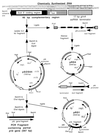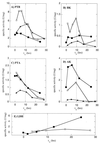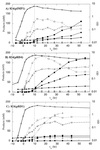Antisense RNA strategies for metabolic engineering of Clostridium acetobutylicum
- PMID: 10049845
- PMCID: PMC91126
- DOI: 10.1128/AEM.65.3.936-945.1999
Antisense RNA strategies for metabolic engineering of Clostridium acetobutylicum
Abstract
We examined the effectiveness of antisense RNA (as RNA) strategies for metabolic engineering of Clostridium acetobutylicum. Strain ATCC 824(pRD4) was developed to produce a 102-nucleotide asRNA with 87% complementarity to the butyrate kinase (BK) gene. Strain ATCC 824(pRD4) exhibited 85 to 90% lower BK and acetate kinase specific activities than the control strain. Strain ATCC 824(pRD4) also exhibited 45 to 50% lower phosphotransbutyrylase (PTB) and phosphotransacetylase specific activities than the control strain. This strain exhibited earlier induction of solventogenesis, which resulted in 50 and 35% higher final concentrations of acetone and butanol, respectively, than the concentrations in the control. Strain ATCC 824(pRD1) was developed to putatively produce a 698-nucleotide asRNA with 96% complementarity to the PTB gene. Strain ATCC 824(pRD1) exhibited 70 and 80% lower PTB and BK activities, respectively, than the control exhibited. It also exhibited 300% higher levels of a lactate dehydrogenase activity than the control exhibited. The growth yields of ATCC 824(pRD1) were 28% less than the growth yields of the control. While the levels of acids were not affected in ATCC 824(pRD1) fermentations, the acetone and butanol concentrations were 96 and 75% lower, respectively, than the concentrations in the control fermentations. The lower level of solvent production by ATCC 824(pRD1) was compensated for by approximately 100-fold higher levels of lactate production. The lack of any significant impact on butyrate formation fluxes by the lower PTB and BK levels suggests that butyrate formation fluxes are not controlled by the levels of the butyrate formation enzymes.
Figures



References
-
- Andersch W, Bahl H, Gottschalk G. Level of enzymes involved in acetate, butyrate, acetone, and butanol formation by Clostridium acetobutylicum. Eur J Appl Microbiol Biotechnol. 1983;18:327–332.
-
- Bradford M M. A rapid and sensitive method for the quantitation of microgram quantities of protein utilizing the principle of protein-dye binding. Ann Biochem. 1976;72:248–254. - PubMed
Publication types
MeSH terms
Substances
Grants and funding
LinkOut - more resources
Full Text Sources
Other Literature Sources
Molecular Biology Databases

